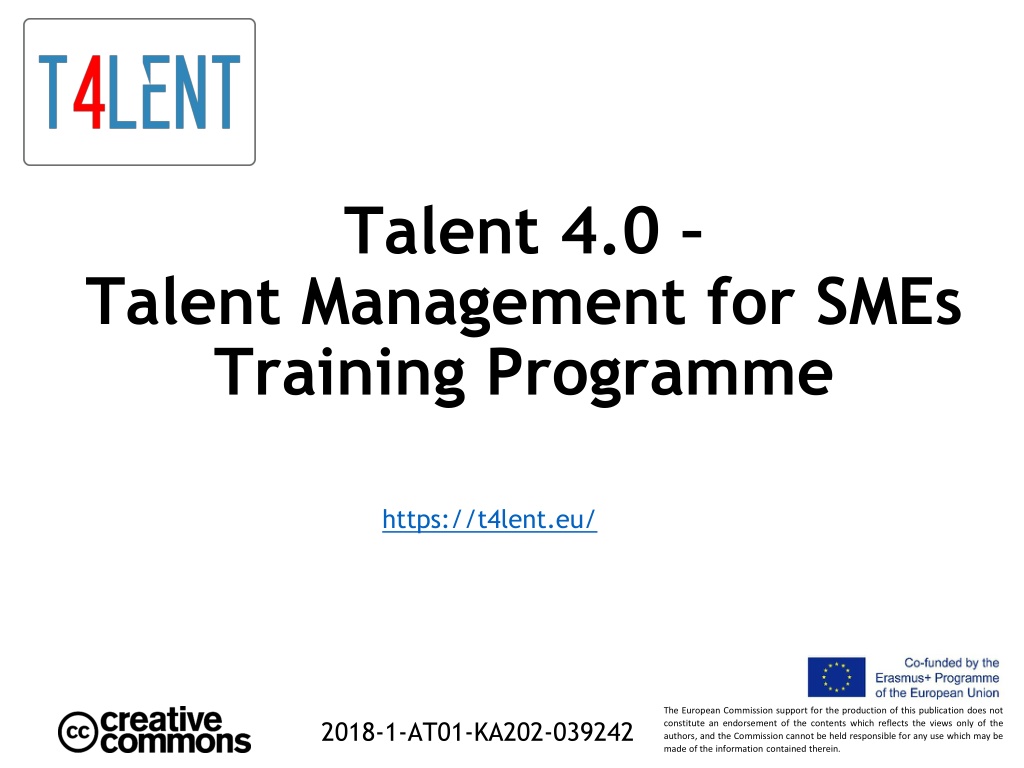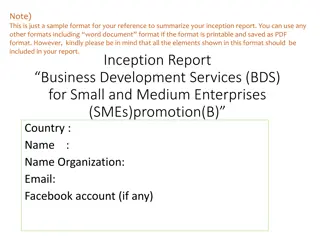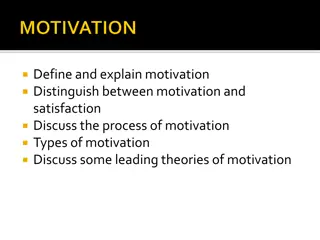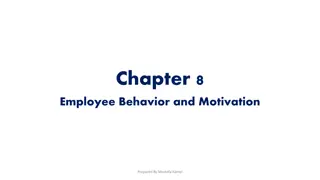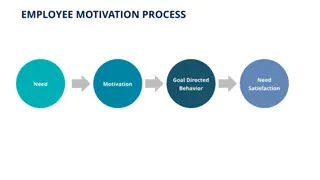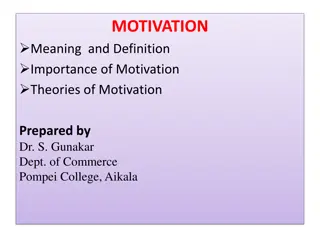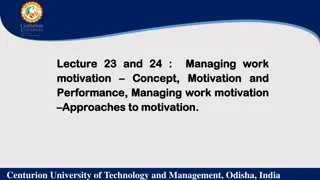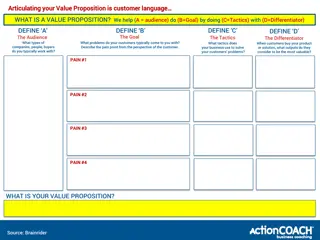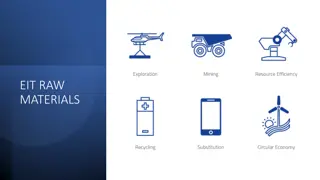Enhancing Employee Motivation in SMEs
Understanding and measuring employee motivation is crucial for SMEs to succeed. This training program provides insights on checklists, indicators, and methods to evaluate motivation, ultimately aiming to improve performance and retention rates within organizations.
Download Presentation

Please find below an Image/Link to download the presentation.
The content on the website is provided AS IS for your information and personal use only. It may not be sold, licensed, or shared on other websites without obtaining consent from the author. Download presentation by click this link. If you encounter any issues during the download, it is possible that the publisher has removed the file from their server.
E N D
Presentation Transcript
Talent 4.0 Talent Management for SMEs Training Programme https://t4lent.eu/ The European Commission support for the production of this publication does not constitute an endorsement of the contents which reflects the views only of the authors, and the Commission cannot be held responsible for any use which may be made of the information contained therein. 2018-1-AT01-KA202-039242
M4: How to motivate your Employees Unit 2: How to measure Employee Motivation Prepared by IHK-Projektgesellschaft www.ihk-projekt.de Germany The European Commission support for the production of this publication does not constitute an endorsement of the contents which reflects the views only of the authors, and the Commission cannot be held responsible for any use which may be made of the information contained therein. 2018-1-AT01-KA202-039242
Learning Outcomes This module aims to guide and help learners to understand: 1. Checklists to measure employee motivation 2. Indicators to measure employee motivation 3. How to measure employee motivation ? 4. Motivating Employees Through Performance Appraisals The European Commission support for the production of this publication does not constitute an endorsement of the contents which reflects the views only of the authors, and the Commission cannot be held responsible for any use which may be made of the information contained therein. 2018-1-AT01-KA202-039242
Introduction One of the most important goals of every company is to have employees who are high performing and are motivated to work at all times. Achieving this is often cumbersome because of the dynamic and complex behaviour of workers. Employee motivation comes from having a sense of purpose, as well as enough support and security to make daily work feel meaningful. Sometimes it can be hard to evaluate how motivated your people are, especially if leaders are not in daily or even weekly contact with all their subordinates. The European Commission support for the production of this publication does not constitute an endorsement of the contents which reflects the views only of the authors, and the Commission cannot be held responsible for any use which may be made of the information contained therein. 2018-1-AT01-KA202-039242
Checklist to measure employee motivation Conduct exit interviews on the real reasons people leave your organization. Ask employees who have been with your business longer than five years why they stay with you. Ask new employees what attracted them to your business. Evaluate which departments have better/worse retention rates than others. Create a retention plan for those key individuals that have the greatest impact on profitability and productive. Employing methods to gauge worker engagement and energy can make the job of increasing these factors easier. To evaluate motivation and provide insight, listen to staff input and assess tangible indicators to improve your business methods. The European Commission support for the production of this publication does not constitute an endorsement of the contents which reflects the views only of the authors, and the Commission cannot be held responsible for any use which may be made of the information contained therein. 2018-1-AT01-KA202-039242
Indicators to measure employee motivation 1.Number of days working at home There s nothing wrong with employees occasionally working from home, as there are countless examples of when it s good for both the company and the employee. 2.Number of absences Another sign of an ailing atmosphere in the organisation is an increase in absences. 3.Number of shorter days Are employees regularly working less hours than their employment contract dictates? 4.Carelessness When you are highly motivated, you are also likely to plough through every last detail and deliver only the finest work. 5.Unsocial behavior Even if there s a clear vision and long-term goals giving guidelines, people are less motivated to perform their best in a poor atmosphere at work. 6.Unwillingness to take responsibility or accept new projects Highly motivated employees jump into new assignments and take personal care that projects are delivered, and customers serviced excellently. Source : https://www.sympa.com/insights/blog/6-basic-hr-metrics-for-measuring-employee-motivation/ The European Commission support for the production of this publication does not constitute an endorsement of the contents which reflects the views only of the authors, and the Commission cannot be held responsible for any use which may be made of the information contained therein. 2018-1-AT01-KA202-039242
How to measure? Surveys Prepare employee surveys with questions that target motivation. Ask workers directly about their job satisfaction. Give them a section to explain what they are getting and what they need in creative opportunities, compensation and benefits, and resources and support. Attendance One way to judge how motivated your employees are at work is to look at how frequently they miss it. Look at your workers' attendance reports for the past six months. Consider the overall amounts of absences. Participation Managers interested in judging the motivation of their employees can learn much from their participatory actions. Associates who respond to needs of their supervisors and other employees show enthusiasm for their jobs. Results Assessing the output from employees is a way of measuring their engagement in their work. For example, look at results such as recent profits to gauge staff involvement. Also, evaluate the quality of the work your staff is producing and the timeliness of work tasks completion. Growth A lack of growth most often means worker motivation is low. When a company stagnates, it is often due to the lack of achievement of its workforce. Source: https://yourbusiness.azcentral.com/evaluate-motivation-9669.html The European Commission support for the production of this publication does not constitute an endorsement of the contents which reflects the views only of the authors, and the Commission cannot be held responsible for any use which may be made of the information contained therein.
Motivating Employees Through Performance Appraisals When employees have goals, they tend to be more motivated if they also receive feedback about their progress. Feedback may occur throughout the workday, but many companies also have a formal, company-wide process of providing feedback to employees, called the performance appraisal. A performance appraisal is a process in which a rater or raters evaluate the performance of an employee. More specifically, during a performance appraisal period, rater(s) observe, interact with, and evaluate a person s performance. Performance appraisals can be important tools to give employees feedback and aid in their development. In many companies, appraisals are used to distribute rewards such as bonuses, annual pay raises, and promotions. They may also be used to document termination of employees. Source: https://saylordotorg.github.io/text_organizational-behavior-v1.1/s10-designing-a-motivating-work-en.html The European Commission support for the production of this publication does not constitute an endorsement of the contents which reflects the views only of the authors, and the Commission cannot be held responsible for any use which may be made of the information contained therein.
Performance Appraisals Performance appraisals involve observing and measuring an employee s performance during an appraisal period, recording these observations, communicating results to the employee, and recognizing high performance while devising ways of improving deficiencies. Most appraisals are conducted by the supervisor, but there are many advantages to using 360-degree appraisals. Appraisals that are more effective give employees adequate notice, fair hearing, and judgment based on evidence. Some companies use relative rankings in which employees are compared to each other, but this system is not suitable for all companies. A performance appraisal meeting should be planned and executed carefully, with the supervisor demonstrating empathy and support. There are intentional and unintentional biases inherent in appraisals and being aware of them, increasing rater accountability, and training managers may be useful in dealing with some of them. Source: https://saylordotorg.github.io/text_organizational-behavior-v1.1/s10-designing-a-motivating-work-en.html The European Commission support for the production of this publication does not constitute an endorsement of the contents which reflects the views only of the authors, and the Commission cannot be held responsible for any use which may be made of the information contained therein.
Exercises 1. How would you ensure that employees are committed to the goals set for them? 2. What are the disadvantages of using only supervisors as the rater? What are the disadvantages of using peers, subordinates and customers as raters? 3. Do you believe that self-appraisals are valid? Why would it be helpful to add self-appraisals to the appraisal process? Can you think of any downsides to using them? The European Commission support for the production of this publication does not constitute an endorsement of the contents which reflects the views only of the authors, and the Commission cannot be held responsible for any use which may be made of the information contained therein. 2018-1-AT01-KA202-039242
Summary/Conclusion It is difficult to grow your small business if you cannot measure the motivation level of your employees. Employing methods to gauge worker engagement and energy can make the job of increasing these factors easier. To evaluate motivation and provide insight, listen to staff input and assess tangible indicators to improve your business methods. In today's challenging economy it is more important than ever to have motivated workforce. Companies, regardless of manufacturing or service, are now realizing the impact of motivated employees who, in the past, were considered as just like another input of production of goods and services. The European Commission support for the production of this publication does not constitute an endorsement of the contents which reflects the views only of the authors, and the Commission cannot be held responsible for any use which may be made of the information contained therein. 2018-1-AT01-KA202-039242
Thank you for watching! The European Commission support for the production of this publication does not constitute an endorsement of the contents which reflects the views only of the authors, and the Commission cannot be held responsible for any use which may be made of the information contained therein. 2018-1-AT01-KA202-039242
Sources: Pictures: 1. Bild von Arek Socha auf Pixabay 2 Bild von Peggy und Marco Lachmann-Anke auf Pixabay The European Commission support for the production of this publication does not constitute an endorsement of the contents which reflects the views only of the authors, and the Commission cannot be held responsible for any use which may be made of the information contained therein. 2018-1-AT01-KA202-039242
